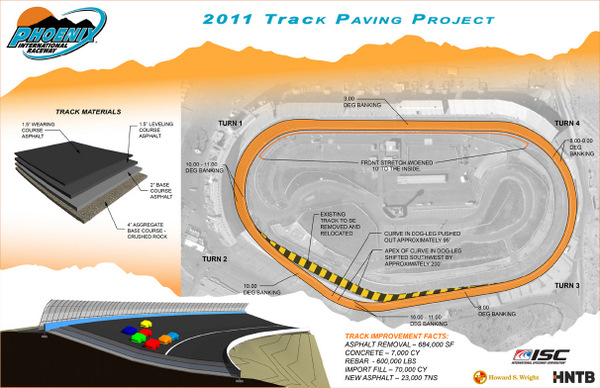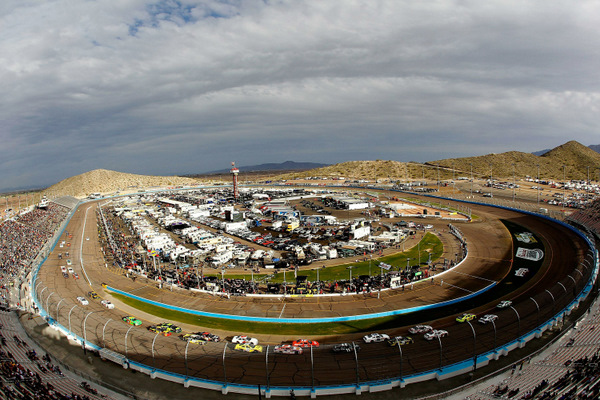Remember when a NASCAR repave would strike terror in the hearts of racers? But no more....

Here's a championship wild card this season -- a new layout for Phoenix International Raceway for the Nov. 13th race (Photo: PIR)
By Mike Mulhern
mikemulhern.net
PHOENIX
You've heard those old horror stories:
When 'new NASCAR asphalt' used to raise a warning cry among teams and tire engineers – back when repaving a NASCAR race track would almost inevitably create a monster of problems.
Remember the infamous repaving job a few years back at North Wilkesboro Speedway….with asphalt so soft that drivers were literally digging ruts in the track coming off turn four?
Remember Bristol asphalt, which tore up so badly in the first and third turns each NASCAR race that they finally just rebuilt it in indestructible concrete?
Remember that Michigan repave, where turn three was tearing up race weekend, and the only quick solution was to 'salt' the corner with lime?
Remember that third turn pot hole at Martinsville, that ate Jeff Gordon's car?
Remember the early years at New Hampshire Motor Speedway where the asphalt would invariably tear up so badly after each race that Bob Bahre had to keep repaving?
And if the asphalt did hold up, then the tires would blister and blow, with maddening regularity. Remember the infamous Indianapolis race on that newly-groove asphalt?
But those were the bad old days.
Somewhere along the line, it all changed, and quite dramatically.
Now when a NASCAR track does a repaving project, the whole deal goes so smoothly that it's almost ho-hum.
And consider last week's Daytona 500 as the crowning achievement – picture-perfect asphalt, smooth as glass, yet grippy, and nearly perfect Goodyears.
For those who have followed this story for so many years, through so many repaves and redesigns, Daytona was as good as it gets.
So when Bryan Sperber, Phoenix track president, announces new pavement and a tweaking to the layout, in a six-month project to start Monday morning, drivers, rather than quaking in their boots, are elbowing their way to the door of the Goodyear hauler to put their names in for the tire testing here.

The view of Phoenix International Raceway from atop turn one (Photo: Getty Images for NASCAR)
And championship-potential drivers are looking at this whole thing not with trepidation but with enthusiasm over the wild-card aspect to this fall's title chase.
Well, most drivers. Some, like Tony Stewart, grumble that a new layout here will only detract further from the Phoenix 'mystique.'
And old-school racers in the NASCAR garage aren't enthusiastic generally about these new smooth NASCAR repaves, because they tend to take the 'character' out of track. Certainly that debate could be raised about Daytona, where the old bumps made for a unique racing surface…quite different from the new smooth asphalt.
But Sperber, and many drivers too, would likely prefer a two-groove layout here, which race track engineer Marty Flugger says his simulation computers show will indeed be the result of this project. "If we'd done just a straight repave, it would have been single-file, fastest way around, so we wanted to make some improvements," Flugger says.
Yes, next up, the 'new' Phoenix International Raceway, coming this fall, just in time for NASCAR's championship playoffs.
Sperber unveiled the new track design here Sunday, and Flugger, the engineering whiz for the France family when it comes to new racing pavement (as director of engineering for North American Testing Corp., the construction arm of the family's International Speedway Corp.) provided the technical details.
And now all Sperber needs is to persuade Danica Patrick to drive back here Monday morning from her Scottsdale home to ride the bulldozer that triggers the rebuilding project.
"It's good-bye to an old friend," Sperber says, of the 20-year-old asphalt here that has borne so much NASCAR history.
But 20 years in the Arizona sun has done its damage, as the cracks and bumps here show. "We've got a lot of great memories here….but the truth is it's used up its life-expectancy," Sperber says.
"It's time," Kurt Busch agrees.
Before blueprinting the new layout, Flugger and his staff analyzed the current configuration and picked apart its problems.
First, Flugger saw that teams were 'cheating' on the backstretch dogleg and trying to hit that one correct line into turn three. So he's changing the dogleg, actually making it more pronounced, moving the apex further away from turn three, and adding a bit more banking to the outside line. He says that will allow drivers to come off turn two and run side by side down the backstretch and into turn three and four.
Flugger also saw that restarts have been problematic here, so he is widening the frontstretch. And he's added a bit of banking to the outside line into turn one and increased the radius to the turn, which is a much tighter corner than three and four.
The changes, at the end of the project, may seem relatively subtle.
But new technology – like the new asphalt-polymers that have proven such a racing success at so many of NASCAR's recent repaves, and Goodyear's own new machinery for micro-analyzing the actual racing surface – should make a big difference in the racing itself.
Tire testing here?
Heck, Goodyear didn't really have to do tire testing at Daytona after that recent repave, just running a mid-December test to confirm its computer analysis, which was amazingly spot-on.
Stu Grant, the Goodyear racing boss who has presided over that company's remarkable engineering revamp the past three years, is positively beaming over how Daytona turned out.
Talk about a home run…
"What I was really impressed with was we were able to develop a tire, manufacturer 8,000 tires for the Daytona 500, NASCAR's premier race, and to do it without a tire test – and to nail it," Grant said.
"Repaves are always a challenge; you never know quite what you're going to get."
But there hasn't been a bad NASCAR repave in years.
"But Talladega, Darlington, Las Vegas, Daytona, they've all gone really well," Grant says. "The industry is a lot smarter now, in terms of formulation of the asphalt. It goes down and it stays down. It doesn't come apart. They're figured out a mix to make the track smooth and keep it together."
Goodyear doesn't have to get involved in the complexities of the repaving process itself or the asphalt mix, but what it does do is intensive study and analysis of the surface characteristics of the asphalt.
"We'll use a lot of the same tools we used at Phoenix that we used at Daytona…but we should be able to have a tire test here before we come back to race in the fall," Grant said.
Next up for Goodyear's Grant and his men are tire tests at Darlington, Dover and Indianapolis. "Part of the battle for us to stay ahead of the cars and the aging of the tracks," Grant says.
So when will a stock car be out on this new Phoenix asphalt? The job is supposed to be done – painting, scoring loops, soft walls and all – by mid-September. By then the asphalt should have three weeks or so of curing. "So by the end of September they should probably be able to get a car on the track," Flugger says.
The Phoenix heat? "The heat is actually good," Flugger says. "It's cold weather that's more a problem."
Flugger, fresh off the success of his Daytona repave, is feeling quite confident about this next project, with its four-inch-deep base, topped with five inches of coursed asphalt. "Once we strip the track off, we'll evaluate the sub-grade a little further.
Daytona's base of lime rock was quite good, very deep in corners and solid, though it had to be shaved down smoother, to eliminate the bumps.
Phoenix' new asphalt will be a similar polymer asphalt to that used at Daytona. After it's mixed, and before it's actually laid, Flugger will analyze it "for softening points, elongation…to see how that material can handle the heat and the stress. We've honed in a spec now that we'll be very happy with here; we've done a lot of tracks – Darlington, Daytona, Talladega, Homestead, Richmond, Martinsville….
"Darlington was a fun track to do….but it was a very difficult track, because it has significant variable banking – whether they originally intended that way or not. Every 10 or 11 feet (width) lane had to be paved right back the way it was done originally, because they wanted to keep the configuration."
The next project will likely be Watkins Glen, which has already undergone some major redesign.

While Daytona winner Trevor Bayne lives the dream, time marches on....and the next time out here, he'll face some new asphalt (Photo: Getty Images for NASCAR)
© 2010-2011 www.mikemulhern.net All rights reserved.
Web site by www.webdesigncarolinas.com







Racetrack Paving Experience
Lane Construction did Talladega & Daytona. Wonder if Phoenix is using them? They did the final Texas repave, too. The key seems to be getting an experienced paving crew. This ain't I-95, boys!
- RA Eckart -
Post new comment